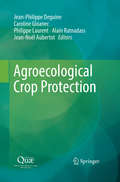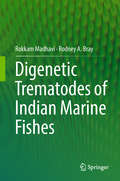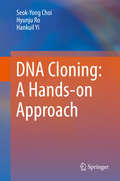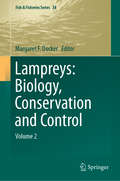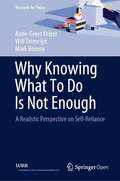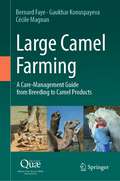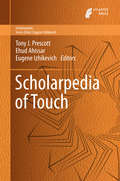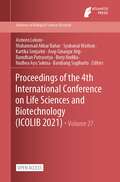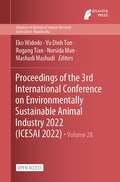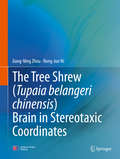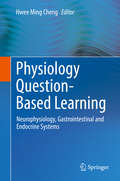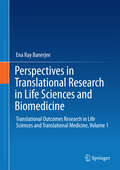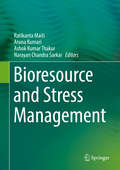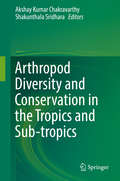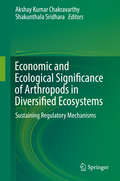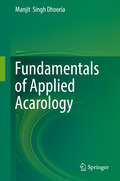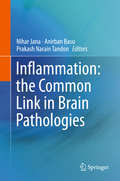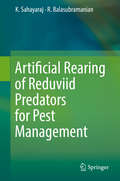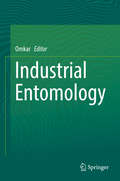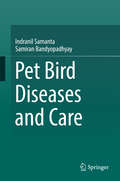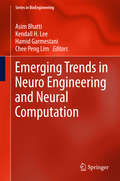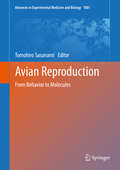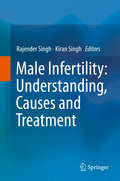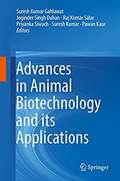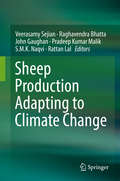- Table View
- List View
Agroecological Crop Protection
by Jean-Philippe Deguine Caroline Gloanec Philippe Laurent Alain Ratnadass Jean-Noël AubertotThis book is devoted to Agroecological Crop Protection, which is the declension of the principles of agroecology to crop protection. It presents the concepts of this innovative approach, case studies and lessons and generic keys for agroecological transition. The book is intended for a wide audience, including scientists, experimenters, teachers, farmers, students. It represents a new tool, proposing concrete keys of action on the basis of feedbacks validated scientifically. Beyond the examples presented, it is therefore of general scope and proposes recommendations for all temperate and tropical cropping systems. It contributes to the training and teaching modules in this field and it is an updated information support for professionals and a teaching aid for students (agronomy, crop protection, biodiversity management, agroecology).
Digenetic Trematodes of Indian Marine Fishes
by Rokkam Madhavi Rodney A. BrayThis book is the first to explore in detail the systematics and taxonomy of the digenean fauna of fish in Indian marine waters. It includes morphological descriptions of 648 species in 190 genera and 30 families. The figures from the original publications are enhanced and made more attractive. Each description is accompanied by information on hosts and distribution. Digenetic trematodes, usually known as Digeneans, are the most diverse group of metazoan parasites of marine fishes. They are parasitic flatworms (Phylum Platyhelminthes) with a complex life-cycle and as adults inhabit mainly the alimentary system and associated organs, but also occur in the blood, under the scales, in the body cavity and in the gall and urinary bladders. Keys to families, genera and species are provided, except for a few large and controversial genera, where morphological characters are insufficient for identification. Although there is extensive literature on Digeneans, it is scattered and largely in obscure local journals. Bringing together most of the primary literature on the subject, this book provides a primer for further study and a starting point for the use of modern molecular methods for the fauna of this region. Unique in its scope, it is a valuable resource for students, professional parasitologists and ecologists as well as fishery and wildlife biologists.
DNA Cloning: A Hands-on Approach
by Seok-Yong Choi Hyunju Ro Hankuil YiThis book offers step-by-step instruction on DNA cloning, defined as moving genes around plasmids, mutating genes, or mining new genes. The aim is to provide those new to the field with reliable and up-to-date practical guidance while at the same time conveying the scope for creativity. After a brief synopsis of the history of cloning, the fundamentals and prerequisites are explained, covering, for example, software, vectors commonly used in the lab, appropriate choice of restriction endonucleases, the preparation of agarose gels, competent cells, and LB agar plates, and procedures to be followed upon receipt of new plasmids. The remainder of the book is devoted to the clear description of methods and individual steps in cloning. Guidance is provided on the cut and paste method, DNA sequencing, direct sequencing, primer design, PCR-based gene insertion and deletion, epitope tag insertion, the use of RACE technology, BAC recombineering, and much, much more. Sources of error and a variety of techniques that make life considerably easier when cloning are also examined in detail.
Lampreys: Volume 2 (Fish & Fisheries Series #38)
by Margaret F. DockerThis book, published in two volumes, provides the most comprehensive review of lamprey biology since Hardisty and Potter’s “The Biology of Lampreys” published more than 30 years ago. This second volume offers a synthesis of topics related to the lamprey gonad (e.g., lamprey sex ratios, sex determination and sex differentiation, sexual maturation, and sex steroids), the artifical propagation of lampreys, post-metamorphic feeding and the evolution of alternative feeding and migratory types, the history and status of sea lamprey control in the Laurentian Great Lakes and Lake Champlain, and an overview of contributions of lamprey developmental studies for understanding vertebrate evolution.
Why Knowing What To Do Is Not Enough: A Realistic Perspective on Self-Reliance (Research for Policy)
by Anne-Greet Keizer Will Tiemeijer Mark BovensThis open access book sets out to explain the reasons for the gap between “knowing” and “doing” in view of self-reliance, which is more and more often expected of citizens. In today’s society, people are expected to take responsibility for their own lives and be self-reliant. This is no easy feat. They must be on constant high alert in areas of life such as health, work and personal finances and, if things threaten to go awry, take appropriate action without further ado. What does this mean for public policy? Policymakers tend to assume that the government only needs to provide people with clear information and that, once properly informed, they will automatically do the right thing. However, it is becoming increasingly obvious that things do not work like that. Even though people know perfectly well what they ought to do, they often behave differently. Why is this? This book sets out to explain the reasons for the gap between ‘knowing’ and ‘doing’. It focuses on the role of non-cognitive capacities, such as setting goals, taking action, persevering and coping with setbacks, and shows how these capacities are undermined by adverse circumstances. By taking the latest psychological insights fully into account, this book presents a more realist perspective on self-reliance, and shows government officials how to design rules and institutions that allow for the natural limitations in people’s ‘capacity to act’.
Large Camel Farming: A Care-Management Guide from Breeding to Camel Products
by Bernard Faye Gaukhar Konuspayeva Cécile MagnanThis practical guide is intended for all actors in the sector who work with large camelids, whether in breeding, technical advice or veterinary care. It successively describes the general aspects of the species, the physiological bases of reproduction, lactation and feeding, the main production processes, and health and hygiene management in camel breeding. Chapters on slaughter, important camel products and their processing complete the volume.Large camels (camels and Bactrian camels) are domestic animals that are increasingly used in Western countries, as well as in Africa and Asia, for tourism, sport, and production of milk, meat, and wool. In addition, camel husbandry systems are changing, taking a greater share of sedentary systems, specializing in breeding, and intensifying production. At the same time, many veterinarians and breeders are not familiar with the animal, its needs, physiology, diseases, and management, which is often based on practices introduced for cattle and proving ineffective.This work is a practical aid for all interested readers who want to embark on the adventure of working with large camelids in a cultural context where they are not yet a dominant element of the agricultural landscape. The numerous photographs and drawings that support the text make it a unique and entertaining read.
Scholarpedia of Touch (Scholarpedia)
by Tony J. Prescott Ehud Ahissar Eugene IzhikevichScholarpedia’s Encyclopedia of Touch provides a comprehensive collection of peer-reviewed articles written by leading researchers, detailing our current scientific understanding of tactile sensing and its neural substrates in animals including humans. The encyclopedia allows ideas and insights to be shared between researchers working on different aspects of touch and in different species, including research in synthetic touch systems. In addition, this encyclopedia raises awareness of research in tactile sensing and increases scientific and public interest in the field.The articles address subjects including tactile control, whiskered robots, vibrissal coding, the molecular basis of touch, invertebrate mechanoreception, fingertip transducers and tactile sensing.All the articles in this encyclopedia provide in-depth and state-of-the-art scholarly treatment of the academic topics concerned, making it an excellent reference work for academics, professionals and students.
Proceedings of the 4th International Conference on Life Sciences and Biotechnology (Advances in Biological Sciences Research #27)
by Bambang SugihartoThis is an open access book.We are pleased to invite you to participate in the 4th International Confrerence on Life Sciences and Biotechnology, “Towards Sustainable Development: Application of Biosciences to Improve Welfare and Quality of Life“. The International Conference which will be held on by The Department of Biology, Faculty of Mathematics and Natural Sciences, University of Jember November 15-16, 2021.The 1st, 2nd, and 3rd ICOLIB had been successfully held in 2015, 2017, and 2019 in University of Jember, respectively. This year’s conference will be held virtually, and present some outstanding speakers coming from Indonesia, Germany, Nederland, The United States of America and South Korea.
Proceedings of the 3rd International Conference on Environmentally Sustainable Animal Industry 2022 (Advances in Biological Sciences Research #28)
by Eko Widodo Vu Dinh Ton Rugang Tian Norsida Man Mashudi MashudiThis is an open access book.The 3rd ICESAI aims to discuss issues related to the development of an eco-friendly and sustainable livestock industry using smart farming which is related to scientific research and how it is applied. The 3rd ICESAI offers opportunities for the for researchers and the livestock industry from all over the world to share experiences, learn and expand networking on several matters relating to the development of a sustainable and environmentally friendly livestock industry, especially with the implementation of smart farming.
The Tree Shrew (Tupaia belangeri chinensis) Brain in Stereotaxic Coordinates
by Jiang-Ning Zhou Rong-Jun NiThis atlas is currently the most systematic and comprehensive atlas of the tree shrew brain. The purpose of this book is to help scientists acquire accurate coordinates of the brain regions of the tree shrew, which is becoming a popular animal model for a variety of human diseases. This atlas contains series of 192 coronal sections, 36 sagittal sections, and 49 horizontal sections using Nissl staining or acetylcholinesterase histochemistry as well as a series of diagrams in stereotaxic coordinates. Original photomicrographs are obtained at single-cell resolution. In addition, we also referred to magnetic resonance images acquired at 250 um intervals with a magnetic resonance scanner 9.4T. Many brain structures are first identified in tree shrews and accurately presented in a stereotaxic coordinate system. The Bregma coordinates system is used for the first time in this tree shrew brain atlas. The atlas represents the collaboration between two indispensable skills of brain research, neuroanatomy and stereotaxic surgery. It will be extensively used in neuroscience research, particularly tree shrew brain study, and will help graduate students and researchers understand brain anatomy and acquire accurate reference coordinates.
Physiology Question-Based Learning: Neurophysiology, Gastrointestinal and Endocrine Systems
by Hwee Ming ChengThis book provides the reader with a range of questions and explanations related to essential aspects of the neural, hormonal and gastrointestinal physiology. The focus of the book is on understanding the homeostatic control in each system by using questions to challenge the reader to think through physiology. In addition, functional integration of the different organ systems is highlighted in an area such as neuroendocrinology and in the study of the neural mechanisms in the gastrointestinal tract. This is the second Physiology Question-Based Learning book, written by Prof. Dr. Cheng. He has taught physiology for thirty years. He has pioneered the international physiology quiz, which is now an annual event at the University of Malaya in Kuala Lumpur, Malaysia and at universities around the world. As quiz master, he has designed challenging questions to test concepts and understanding in physiology. This book reflects the style of questions asked during the physiology quiz. The questions are designed to stimulate integrative and homeostatic thinking in physiology. The Physiology Question-Based Learning books will be helpful to all students of Physiology in medicine, dentistry, pharmacy and allied health sciences. This work is written to make physiology learning engaging and enjoyable and to encourage effective teaching in physiology.
Perspectives in Translational Research in Life Sciences and Biomedicine: Translational Outcomes Research in Life Sciences and Translational Medicine, Volume 1
by Ena Ray BanerjeeThe present book addresses the multi-disciplinary nature of Translational Outcomes Research, which is a watershed for nearly all the disciplines of Life and Health Sciences, along with the Materials Sciences including but not limited to Zoology, Botany, Microbiology, Biochemistry, Physiology, Nanotechnology, the Medical Sciences, Bioengineering, Biophysics, Medicinal Chemistry, Structural Biology, Biostatistics and Bioinformatics. This book, for the first time, addresses the basic premises of fundamental research in facilitating drug discovery. One chapter is dedicated to a novel generation of platforms with novel camelid antibodies and their technological extensions, while another focuses on functional food and nutraceuticals. The book begins with a thorough overview of what translational outcomes research connotes and what the current status of research in the area is, and goes on to elucidate various pertinent preclinical disease models and their uses in basic and application based research in the Life Sciences. How basic approaches to screening and characterization vis-à-vis their role in amelioration of the two cardinal problems of inflammation and degeneration involved in most diseases is elucidated. The book ends with a discussion of the relevance and importance of using Bio Green technology in Translational Outcomes, addressing the need to fill the gap between academia and industry and clinics that can arise through direct or indirect collaboration between the stakeholders and emphasizing the need for an eco-friendly approach so as not to jeopardize the fine balance that holds life on earth in harmony.
Bioresource and Stress Management
by Ratikanta Maiti Aruna Kumari Ashok Kumar Thakur Narayan Chandra SarkarThis book is a compilation of recent global measures to conserve bio-resources and manage biotic and abiotic stresses. It highlights emerging issues related to agriculture, abiotic and biotic stress factors, ethnic knowledge, climate change and global warming, as well as natural resources and their sustainable management. It also focuses on the consolidated efforts of scientists and academics engaged in addressing a number of issues related to resource management and combating stresses in order to protect the Earth. Crop production and productivity have been significantly improved, however, there have been no corresponding practical advances in sustainable agriculture.This book offers a wide range of affordable approaches to managing bio-resources with a focus on sustainability. Lastly, it describes research highlights and future areas of research.
Arthropod Diversity and Conservation in the Tropics and Sub-tropics
by Akshay Kumar Chakravarthy Shakunthala SridharaArthropods are invertebrates that constitute over 90% of the animal kingdom, and their bio-ecology is closely linked with global functioning and survival.Arthropods play an important role in maintaining the health of ecosystems, provide livelihoods and nutrition to human communities, and are important indicators of environmental change. Yet the population trends of several arthropods species show them to be in decline. Arthropods constitute a dominant group with 1.2 million species influencing earth’s biodiversity. Among arthropods, insects are predominant, with ca. 1 million species and having evolved some 350 million years ago. Arthropods are closely associated with living and non-living entities alike, making the ecosystem services they provide crucially important. In order to be effective, plans for the conservation of arthropods and ecosystems should include a mixture of strategies like protecting key habitats and genomic studies to formulate relevant policies for in situ and ex situ conservation.This two-volume book focuses on capturing the essentials of arthropod inventories, biology, and conservation.Further, it seeks to identify the mechanisms by which arthropod populations can be sustained in terrestrial and aquatic ecosystems, and by means of which certain problematic species be managed without producing harmful environmental side-effects.This edited compilation includes chapters contributed by over 80 biologists on a wide range of topics embracing the diversity, distribution, utility and conservation of arthropods and select groups of insect taxa. More importantly, it describes in detail the mechanisms of sustaining arthropod ecosystems, services and populations. It addresses the contribution of modern biological tools such as molecular and genetic techniques regulating gene expression, as well as conventional, indigenous practices in arthropod conservation. The contributors reiterate the importance of documenting and understanding the biology of arthropods from a holistic perspective before addressing conservation issues at large. This book offers a valuable resource for all zoologists, entomologists, ecologists, conservation biologists, policy makers, teachers and students interested in the conservation of biological resources.
Economic and Ecological Significance of Arthropods in Diversified Ecosystems: Sustaining Regulatory Mechanisms
by Akshay Kumar Chakravarthy Shakunthala SridharaArthropods are invertebrates that constitute over 90% of the animal kingdom, and their bio-ecology is closely linked with global functioning and survival.Arthropods play an important role in maintaining the health of ecosystems, provide livelihoods and nutrition to human communities, and are important indicators of environmental change. Yet the population trends of several arthropods species show them to be in decline. Arthropods constitute a dominant group with 1.2 million species influencing earth’s biodiversity. Among arthropods, insects are predominant, with ca. 1 million species and having evolved some 350 million years ago. Arthropods are closely associated with living and non-living entities alike, making the ecosystem services they provide crucially important. In order to be effective, plans for the conservation of arthropods and ecosystems should include a mixture of strategies like protecting key habitats and genomic studies to formulate relevant policies for in situ and ex situ conservation.This two-volume book focuses on capturing the essentials of arthropod inventories, biology, and conservation. Further, it seeks to identify the mechanisms by which arthropod populations can be sustained in terrestrial and aquatic ecosystems, and by means of which certain problematic species be managed without producing harmful environmental side-effects. This edited compilation includes chapters contributed by over 80 biologists on a wide range of topics embracing the diversity, distribution, utility and conservation of arthropods and select groups of insect taxa. More importantly, it describes in detail the mechanisms of sustaining arthropod ecosystems, services and populations. It addresses the contribution of modern biological tools such as molecular and genetic techniques regulating gene expression, as well as conventional, indigenous practices in arthropod conservation. The contributors reiterate the importance of documenting and understanding the biology of arthropods from a holistic perspective before addressing conservation issues at large. This book offers a valuable resource for all zoologists, entomologists, ecologists, conservation biologists, policy makers, teachers and students interested in the conservation of biological resources.
Fundamentals of Applied Acarology
by Manjit Singh DhooriaAcarology - the study of mites and ticks, is a subdiscipline of Zoology, and is many times considered in the field of Entomology (the study of insects). Mites and ticks are distributed throughout the world and inhabit almost every ecosystem (both terrestrial and aquatic) including grassland soils. More than 55,000 species of mites and ticks are already described. Mites and ticks directly affects humans as pests of different crops, fruit plants, vegetable crops and field crops; as parasites of human beings, veterinary animals, poultry and pets; pests of stored grains and other products; mushrooms and cheese; and as parasites of honeybees. Mite infestations are responsible for economic losses worth billions of dollars in terms of reduced crop yields and lowered quality of produce. Many species of mites serve as vectors of various plant diseases; some species of ticks cause losses through blood feeding and by transmitting many diseases among man and animals. House-dust mite allergies, and tick bite allergies are also common in many parts of the world.Present Book, "Fundamentals of Applied Acarology," is written keeping in view non-availability of any standard text dealing in different aspects of acarology at one place. Separate chapters in this book are devoted to Importance of Acarology, Historical account, acarine technology, morphology and anatomy of Acari; Feeding, Development and Reproduction. Molecular developments in relation to mites and ticks are also discussed. Role of mites and ticks in Quarantines of plants and animals; forensic/criminal investigations; and importance of accidental acarophagy are discussed in detail. Safe usage of pesticides based on their mode of action (IRAC’s Groups), development of acaricide resistance and measures to mitigate it are discussed. Mite pests of fruit trees, vegetable plants, and floricultural plants; field crops; mite problems in greenhouses/polyhouses; and mite problems encountered under organic cultivation of plants; and their management through minimum usage of pesticides are emphasized. Role of different predaceous mites in controlling plant pests like thrips, aphids and scale insects is elaborately discussed. Biological control of phytophagous mites is discussed in detail. Different animal parasitic mites and ticks are discussed from veterinary and medical point of view.At the end of each chapter, many important references for further reading; and Electronic References (ER) in the form of youtube links and other weblinks are given to understand fully how these tiny creatures look like; behave, feed and reproduce; nature of damage they cause to plants and animals; and measures to mitigate them. Weblinks will stimulate interest in the readers for more information about different mites and ticks. The knowledge contained in the book may prove as best material for "General and Applied Acarology" course for graduate and post-graduate levels, teachers and researchers in entomology, pest control advisors, professional entomologists, pesticide industry managers, policy planners, and others having interest in mites and ticks.
Inflammation: the Common Link in Brain Pathologies
by Nihar Jana Anirban Basu Prakash Narain TandonThis unifying theme of this book-with sections on mechanisms of defense and neuropathogenesis, neurological diseases, infections of the nervous system, neuropharmacology, and novel therapies-is interactions of the immune and nervous systems. It also discusses the role of inflammation as a key mediator of different brain disorders. There have been significant scientific advances in the multidisciplinary field of neuroimmunology / neuroinflammation in the past decade, and this book, edited under the guidance of Professor P. N. Tandon, fosters communication between those who share an interest in this exciting area, including neuroscientists, immunologists, cell biologists, clinicians and neuropharmacologists.
Artificial Rearing of Reduviid Predators for Pest Management
by K. Sahayaraj R. BalasubramanianThis eye-opening book focuses on the development of techniques to mass-produce reduviid predators and important generalist predators, an endeavor that won’t prove sufficient if the cost of commercialization is prohibitive. Advancing mass production to the level of economic feasibility is critical, so that these new technologies can compete in the open market. This book commences with a review of the diversity of reduviid predators in agro-ecosystems world-wide, followed by chapters on their feeding behavior, biology, gut microbiota, their enzyme profile, body protein and genomics, and DNA and field evaluation reports. The field evaluation of reduviids, a worldwide undertaking, is addressed in the last chapter. Each chapter includes a separate conclusion and future recommendations. Detailed information is also included on ingredients and artificial diet preparation, storage and the impact on predators. The artificial rearing of reduviid predator for crop pest management is an essential reference and teaching tool for teachers, researchers and extension workers in developed and developing countries alike, allowing them to produce reduviid predators and important natural enemies in biocontrol and bio-intensive integrated pest management programs. The book offers an excellent resource for all those who are working on beneficial arthropod mass production. It is also an essential reference guide for agricultural and biological sciences scientists, entomologists, crop protection specialists, extension workers, and consultants.
Industrial Entomology
by OmkarThis book is a compilation of writings focused on conventional and unconventional insect products. Some of these products are commercials successes, while others are waiting to be launched and are the potential produce of the future. In addition to the well known products honey, mulberry silk, and lac, the book primarily concentrates on silk producing insects other than the mulberry silkworm, insects as food, as sources of medicines, pest and weed managers, and as pollinators. The book highlights the all pervasive role of insects in improving human lives at multiple levels. Accordingly, while most books on insects concentrate on how to limit growth in their population, it instead focuses on how to propagate them. In each chapter, the book brings to the fore how insects are far more beneficial to us than their well publicised harmful roles. This book approaches both unconventional and conventional insect products, such as honey, silk and lac in much more depth than the available literature. It investigates different aspects of the production of these insects, such as the related processes, problems and utilities, in dedicated chapters. Because this book deals with the production of insects or their produce, it has been named Industrial Entomology, perhaps the only book that truly reveals the tremendous potential of insects to help humans live better lives. Based on the research and working experience of the contributors, who are global experts in their respective fields, it provides authentic, authoritative and updated information on these topics. The book offers a unique guide for students, teachers, policy planners, small scale industrialists, and government ministries of agriculture and industry across the globe. It will provide a much required stimulus to insect appreciation and generate enthusiasm for research and the broader acceptance for insect produce. Hopefully, it will also present the Indian perspective on these topics to a global readership.
Pet bird diseases and care
by Indranil Samanta Samiran BandyopadhyayThis book provides fundamental information on pet birds, menaces, and advances made in the diagnosis and treatment of menaces. It is the only book covering all species of pet birds, menaces and their individual management. The handful of related books available worldwide are largely outdated and focus on a single species or breed of pet bird. The book encompasses the history of bird keeping, common breeds of birds, their nutritional requirements, list of zoonotic diseases transmitted by birds and guideline for their prevention. It covers infectious, non-infectious clinical and metabolic diseases, and toxicity in detail with a special focus on the history of diseases, etiology, affected hosts, pathogenesis, clinical signs, diagnosis and treatment. Separate chapters detail relevant diagnostic techniques, management and care practices, including updated information. The book offers an invaluable guide for students and teachers in the field of (avian) veterinary medicine, scientists/research scholars working in related fields, and avian medicine practitioners, as well as all those progressive bird owners who want to know the basics of their care and management.
Emerging Trends in Neuro Engineering and Neural Computation (Series in BioEngineering)
by Asim Bhatti Kendall H. Lee Hamid Garmestani Chee Peng LimThis book focuses on neuro-engineering and neural computing, a multi-disciplinary field of research attracting considerable attention from engineers, neuroscientists, microbiologists and material scientists. It explores a range of topics concerning the design and development of innovative neural and brain interfacing technologies, as well as novel information acquisition and processing algorithms to make sense of the acquired data. The book also highlights emerging trends and advances regarding the applications of neuro-engineering in real-world scenarios, such as neural prostheses, diagnosis of neural degenerative diseases, deep brain stimulation, biosensors, real neural network-inspired artificial neural networks (ANNs) and the predictive modeling of information flows in neuronal networks. The book is broadly divided into three main sections including: current trends in technological developments, neural computation techniques to make sense of the neural behavioral data, and application of these technologies/techniques in the medical domain in the treatment of neural disorders.
Avian Reproduction: From Behavior to Molecules (Advances in Experimental Medicine and Biology #1001)
by Tomohiro SasanamiThis book provides everything from basic knowledge to the recent understandings of avian reproductive physiology, covering many unique aspects. It will inspire avian biologists as well as researchers in varied fields and will offer important steps towards better fertilization success in birds.In spite of the recent remarkable developments in modern technology, a comprehensive understanding of the reproductive mechanisms is still far in the future due to the diverse reproductive tactics in vertebrates. Birds have highly refined reproductive strategies and some of those strategies are unique to birds. However, together with ongoing progress of the genome analysis of birds and the crying need for further increase in meat and egg production, research on avian reproduction is now accelerating and becoming more important.With contributions by leading scientists, the book explains avian primordial germ cells; the sex-determining mechanism; reproductive endocrinology and immunology; sperm, egg, and egg coat; sperm–egg interaction; polyspermic fertilization; seasonal reproduction; social triggers; hormonal and behavioral changes; broodiness; oviductal sperm storage; and biotechnology. This book is recommended for all researchers and students who are interested in birds or reproduction.
Male Infertility: Understanding, Causes and Treatment
by Rajender Singh Kiran SinghThis book covers the latest research on male infertility. The topics discussed range from understanding the genetic basis of infertility, to its causes and treatment. Since infertility is also of great interest to the general public, the book also includes a detailed description of what infertility is and how one can understand the different types. Given the complex etiology of infertility, the book includes a number of chapters defining the known and probable causes of male infertility. Providing detailed information suitable for patients and clinicians alike, it also features a separate section on treatment, the ultimate goal.
Advances in Animal Biotechnology and its Applications
by Suresh Kumar Gahlawat Joginder Singh Duhan Raj Kumar Salar Priyanka Siwach Pawan KaurThis book explores the recent advancements in cutting-edge techniques and applications of Biotechnology. It provides an overview of prospects and applications while emphasizing modern, and emerging areas of Biotechnology. The chapters are dedicated to various field of Biotechnology including, genome editing, probiotics, in-silico drug designing, nanoparticles and its applications, molecular diagnostics, tissue engineering, cryopreservation, and antioxidants. It is useful for both academicians and researchers in the various disciplines of life sciences, agricultural sciences, medicine, and Biotechnology in Universities, Research Institutions, and Biotech companies. This book provides the readers with a comprehensive knowledge of topics in Genomics, Bionanotechnology, Drug Designing, Diagnostics, Therapeutics, Food and Environmental Biotechnology. The chapters have been written with special reference to the latest developments in the frontier areas of Biotechnology that impacts the Biotech industries.
Sheep Production Adapting to Climate Change
by Veerasamy Sejian Raghavendra Bhatta John Gaughan Pradeep Kumar Malik S.M.K Naqvi Rattan LalThis book presents a compilation of the latest findings from reputed researchers around the globe, covering in detail climate change and its effects on sheep production. In the current global climate change scenario, information related to its impact on livestock agriculture is lacking.The negative impacts of climate change are already being felt by all livestock species. Further, the mitigation and amelioration strategies that are applicable for one species may not hold true for another. As such, concerted research efforts are needed to identify species-specific strategies for mitigation and adaptation. With that goal in mind, this book is the first of its kind to gather comprehensive information pertaining to the impact of climate change on various aspects of sheep production. It also sheds light on the role of sheep with regard to the global greenhouse gas pool. The book highlights the status quo of sheep production from climate change perspectives and projects the significance of adapting future sheep production to the challenges posed by climate change. It addresses in detail the various adaptations, methane mitigation and amelioration strategies needed to sustain sheep production in the future. In addition, the book presents development plans and policies that will allow the sheep industry to cope with current climate changes and strategies that will lessen future impacts. Bringing together essential information prepared by world-class researchers hailing from different agro-ecological zones, this book offers a unique resource for all researchers, teachers and students associated with sustaining the sheep production in the face of global change.
